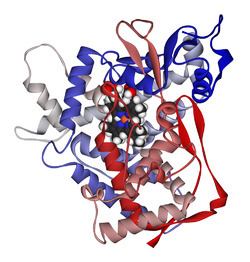EC number 1.14.13.48 Human Mouse | Species Human Entrez 1559 | |
 | ||
Aliases CYP2C9, CPC9, CYP2C, CYP2C10, CYPIIC9, P450IIC9, cytochrome P450 family 2 subfamily C member 9, Cytochrome P450 2C9 External IDs OMIM: 601130 MGI: 1917138 HomoloGene: 133566 GeneCards: CYP2C9 | ||
What is cyp2c9
Cytochrome P450 2C9 (abbreviated CYP2C9) is an enzyme that in humans is encoded by the CYP2C9 gene.
Contents
- What is cyp2c9
- Cyp2c9 tales from the genome
- Function
- Pharmacogenomics
- CYP2C9 Ligands
- Epoxygenase activity
- References
Cyp2c9 tales from the genome
Function
CYP2C9 is an important cytochrome P450 enzyme with a major role in the oxidation of both xenobiotic and endogenous compounds. CYP2C9 makes up about 18% of the cytochrome P450 protein in liver microsomes (data only for antifungal). Some 100 therapeutic drugs are metabolized by CYP2C9, including drugs with a narrow therapeutic index such as warfarin and phenytoin and other routinely prescribed drugs such as acenocoumarol, tolbutamide, losartan, glipizide, and some nonsteroidal anti-inflammatory drugs. By contrast, the known extrahepatic CYP2C9 often metabolizes important endogenous compound such as 5-hydroxytryptamine and, owing to its epoxygenase activity, various polyunsaturated fatty acids, converting these fatty acids to a wide range of biological active products.
In particular, CYP2C9 metabolizes arachidonic acid to the following eicosatrienoic acid epoxide (termed EETs) stereoisomer sets: 5R,6S-epoxy-8Z,11Z,14Z-eicosatetrienoic and 5S,6R-epoxy-8Z,11Z,14Z-eicosatetrienoic acids; 11R,12S-epoxy-8Z,11Z,14Z-eicosatetrienoic and 11S,12R-epoxy-5Z,8Z,14Z-eicosatetrienoic acids; and 14R,15S-epoxy-5Z,8Z,11Z-eicosatetrainoic and 14S,15R-epoxy-5Z,8Z,11Z-eicosatetrainoic acids. It likewise metablizes docosahexaenoic acid to epoxydocosapentaenoic acids (EDPs; primarily 19,20-epoxy-eicosapentaenoic acid isomers [i.e. 10,11-EDPs]) and eicosapentaenoic acid to epoxyeicosatetraenoic acids (EEQs, primarily 17,18-EEQ and 14,15-EEQ isomers). Animal model and a limited number of human studies implicate these epoxides in reducing hypertension; protecting against the Myocardial infarction and other insults to the heart; promoting the growth and metastasis of certain cancers; inhibiting inflammation; stimulating blood vessel formation; and possessing a variety of actions on neural tissues including modulating Neurohormone release and blocking pain perception (see epoxyeicosatrienoic acid and epoxygenase pages).
In vitro studies on human and animal cells and tissues and in vivo animal model studies indicate that certain EDPs and EEQs (16,17-EDPs, 19,20-EDPs, 17,18-EEQs have been most often examined) have actions which often oppose those of another product of CYP450 enzymes (e.g. CYP4A1, CYP4A11, CYP4F2, CYP4F3A, and CYP4F3B) viz., 20-Hydroxyeicosatetraenoic acid (20-HETE), principally in the areas of blood pressure regulation, blood vessel thrombosis, and cancer growth (see 20-Hydroxyeicosatetraenoic acid, Epoxyeicosatetraenoic acid, and Epoxydocosapentaenoic acid sections on activities and clinical significance). Such studies also indicate that the EPAs and EEQs are: 1) more potent than EETs in decreasing hypertension and pain perception; 2) more potent than or equal in potency to the EETs in suppressing inflammation; and 3) act oppositely from the EETs in that they inhibit angiogenesis, endothelial cell migration, endothelial cell proliferation, and the growth and metastasis of human breast and prostate cancer cell lines whereas EETs have stimulatory effects in each of these systems. Consumption of omega-3 fatty acid-rich diets dramatically raises the serum and tissue levels of EDPs and EEQs in animals as well as humans and in humans are by far the most prominent change in the profile of PUFA metabolites caused by dietary omega-3 fatty acids.
CYP2C9 may also metabolize linoleic acid to the potentially very toxic products, vernolic acid (also termed leukotoxin) and coronaric acid (also termed isoleukotoxin); these linoleic acid eoxides cause multiple organ failure and acute respiratory distress in animal models and may contribute to these syndromes in humans.
Pharmacogenomics
Genetic polymorphism exists for CYP2C9 expression because the CYP2C9 gene is highly polymorphic. More than 50 single nucleotide polymorphisms (SNPs) have been described in the regulatory and coding regions of the CYP2C9 gene, some of them are associated with reduced enzyme activity compared with wild type in vitro.
Multiple in vivo studies also show that several mutant CYP2C9 genotypes are associated with significant reduction of in metabolism and daily dose requirements of selected CYP2C9 substrate. In fact, adverse drug reactions (ADRs) often result from unanticipated changes in CYP2C9 enzyme activity secondary to genetic polymorphisms. Especially for CYP2C9 substrates such as warfarin and phenytoin, diminished metabolic capacity because of genetic polymorphisms or drug-drug interactions can lead to toxicity at normal therapeutic doses.
Allele frequencies(%) of CYP2C9 polymorphism
CYP2C9 Ligands
Most inhibitors of CYP2C9 are competitive inhibitors. Noncompetitive inhibitors of CYP2C9 include nifedipine, phenethyl isothiocyanate, medroxyprogesterone acetate and 6-hydroxyflavone. It was indicated that the noncompetitive binding site of 6-hydroxyflavone is the reported allosteric binding site of the CYP2C9 enzyme.
Following is a table of selected substrates, inducers and inhibitors of CYP2C9. Where classes of agents are listed, there may be exceptions within the class.
Inhibitors of CYP2C9 can be classified by their potency, such as:
Epoxygenase activity
CYP2C9 attacks various long-chain polyunsaturated fatty acids at their double (i.e. alkene) bonds to form epoxide products that act as signaling molecules. It along with CYP2C8, CYP2C19, CYP2J2, and possibly CYP2S1 are the principle enzymes which metabolizes 1) arachidonic acid to various epoxyeicosatrienoic acids (also termed EETs); 2) linoleic acid to 9,10-epoxy octadecaenoic acids (also termed vernolic acid, linoleic acid 9:10-oxide, or leukotoxin) and 12,13-epoxy-octadecaenoic (also termed coronaric acid, linoleic acid 12,13-oxide, or isoleukotoxin); 3) docosohexaenoic acid to various epoxydocosapentaenoic acids (also termed EDPs); and 4) eicosapentaenoic acid to various epoxyeicosatetraenoic acids (also termed EEQs). Animal model studies implicate these epoxides in regulating: hypertension, Myocardial infarction and other insults to the heart, the growth of various cancers, inflammation, blood vessel formation, and pain perception; limited studies suggest but have not proven that these epoxides may function similarly in humans (see epoxyeicosatrienoic acid and epoxygenase pages). Since the consumption of omega-3 fatty acid-rich diets dramatically raises the serum and tissue levels of the EDP and EEQ metabolites of the omega-3 fatty acid, i.e. docosahexaenoic and eicosapentaenoic acids, in animals and humans and in humans is the most prominent change in the profile of PUFA metabolites caused by dietary omega-3 fatty acids, EPA and EEQs may be responsible for at least some of the beneficial effects ascribed to dietary omega-3 fatty acids.
